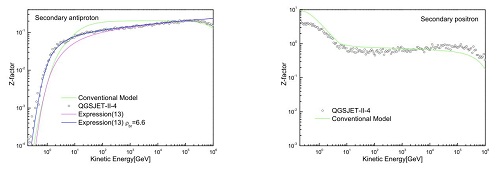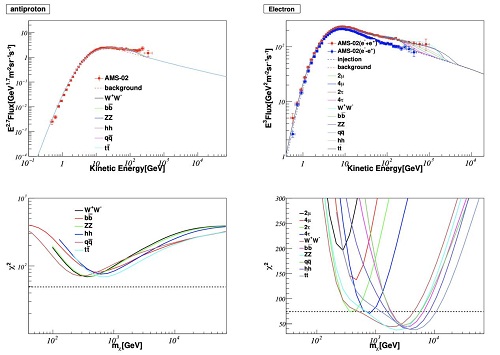Tens GeV dark matter interpreted by antiproton excess is constrained
In recent years, the cosmic ray positron excess above tens GeV beyond the astrophysical background has been considered as possible evidence of dark matter. Since the release of the data of cosmic ray antiprotons from AMS-02 experiment, many papers indicated that there is also excess of cosmic ray antiprotons below 10GeV, which comes from the annihilation or decay of dark matter. However, the paper, published in The Astrophysical Journal with Dr. Hongbo JIN from the National Astronomical Observatories of CAS (NAOC) as the first author, shows that the excess of antiprotons in the GeV energy range is not reasonable. The latest AMS-02 data and QGSJET-II-04 model both prevent that excess.
AMS-02 experiment is a search for antimatter in the universe led by Samuel C. C. Ting, a Nobel laureate in physics. The experiment measured the positrons, antiprotons and a large number of cosmic ray nuclei with high precision, bringing the experiment into the era of precise measurement.
QGSJET-II-04 model is the strong interaction model of elementary particles used to calculate the background of cosmic ray positrons and antiprotons. In the past papers, dark matter interpretation of the low energy excess anti-protons derives from the conventional model, which is not updated based on the latest experimental data, such as LHC etc.
As shown in Figure 1, the calculated results of the QGSJET-II-04 model with a high degree of consistency with the experiment in producing positrons are consistent with most energy regions of the traditional model, while the antiprotons are inconsistent with the conventional model, which indicates the problem of the antiprotons in the low energy excess before. The blue curve on the left is the best model selected to produce antiprotons, and the low energy region is significantly higher than the number of antiprotons produced by the traditional model.

Figure 1: Z factors of antiproton and positron products in the QGSJET-II-04 model compared with the Conventional model. (Credit: Hongbo JIN)
The positron excess predicts mass of dark matter from a few hundred GeV to more than TeV. If antiproton excess is reasonable, the predicted dark matter mass in tens GeV range. That implies the predictions between the positron and antiproton excess are not consistent, which is not convinced in the dark matter detection from cosmic ray experiment.
Based on QGSJET-II-04 model etc., this paper studied the possible mass distribution of dark matter through the energy spectrum analysis of the experiment of AMS-02 related to antiprotons and so on. As can be seen from Figure 2, the mass distribution of dark matter is not accepted above the exclusion line, although various channels of dark matter annihilation are taken into account to produce antiprotons. By the corresponding antiproton energy spectrum, it can also be seen that the low energy region does not go beyond the background. On the contrary, according to the energy spectrum analysis of total electrons in cosmic rays, due to the positron excess, it is obvious that in the energy spectrum of total electron flux of cosmic rays, there is an obvious background excess near TeV. Obviously, there are several annihilation channels below the exclusion line corresponding to the mass distribution of dark matter. It is accepted that the mass range of the predicted dark matter is distributed in the range of several hundred GeV to above TeV. Therefore, such analysis results also confirm the feasibility of relevant experiments to search for dark matter by detecting cosmic rays above TeV.

Figure 2: The X2 distribution of antiprotons and positrons produced by the annihilation of dark matter with different masses to multiple final states (last row) and the associated cosmic ray energy spectrum (first row). (Credit: Hongbo JIN)
The paper can be accessed at https://iopscience.iop.org/article/10.3847/1538-4357/abb01a